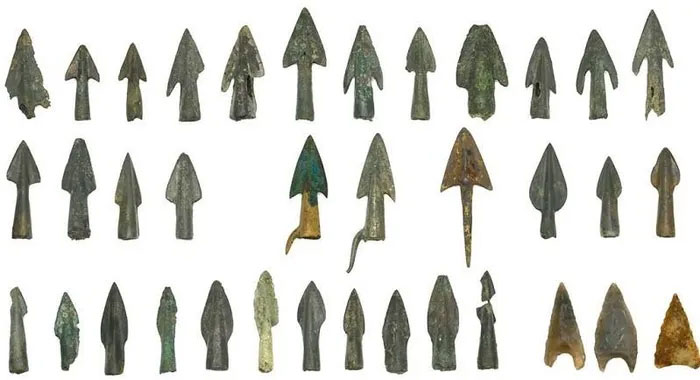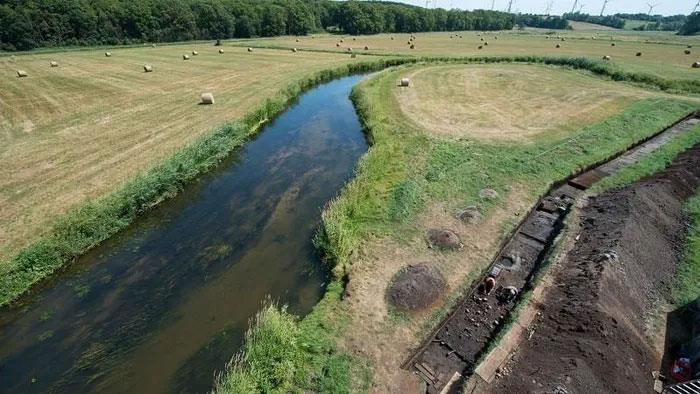Thousands of skeletons and weapons reveal battle 3,250 years ago
A new analysis of dozens of arrowheads is helping researchers piece together a clearer portrait of the warriors who fought on Europe's oldest known battlefield 3,250 years ago.
The bronze and flint arrowheads were found in the Tollense Valley in northeastern Germany. Researchers first discovered the site in 1996 when an amateur archaeologist discovered a bone sticking out of the banks of the Tollense River.

Dozens of arrowheads reveal 3,250-year-old battle.
Since then, excavations have uncovered 300 metal artifacts and 12,500 bones belonging to around 150 individuals who died in battle at the site in 1250 BC. The weapons recovered included swords, wooden clubs, and a series of arrowheads, including some still embedded in the bones of the fallen.
No direct evidence of a previous battle of this scale has ever been discovered, which is why the Tollense Valley is considered the site of the oldest battle in Europe, according to researchers who have been studying the area since 2007.

Tollense Valley in northeastern Germany.
Studies of the bones have yielded some insights into the men - all were young, fit and healthy warriors, some with healed wounds from previous skirmishes.
But researchers have long been clueless about the details of who took part in this violent conflict, and why they fought such a bloody battle.
There are no written records describing this battle, so as archaeological teams excavated more artifacts from the valley, they used the well-preserved relics and weapons to try to piece together the story behind the ancient battle scene.
Now, a team of researchers studying arrowheads used in the battle have discovered evidence that the battle involved both local groups as well as an army from the south.
The findings, published on September 22 in the journal Antiquity, suggest that the clash was a regional conflict in Europe , and raise questions about organized, armed violence that took place thousands of years ago.
'Arrowheads are a kind of "hard evidence" like the murder weapon in a cold case, they give us clues about the perpetrators, the warriors of the Tollense Valley battle and where they came from,' said lead author Leif Inselmann, a researcher at the Berlin Graduate School of Ancient Studies at the Free University of Berlin, in a statement.
The sheer scale of the battle has forced researchers to rethink social organization and warfare in the Bronze Age.
'Were Bronze Age warriors (organized) as a tribal confederation, the retinue or mercenaries of a charismatic leader – a kind of 'warlord' – or even the army of an early kingdom?' Inselmann said.
For a long time, researchers argued that Bronze Age violence was a small-scale affair involving dozens of individuals from local communities, but Tollense has shattered that theory, said Molloy, a member of the research team.
'We have many sites where we have found evidence of mass killings, and even massacres of entire communities, but this is the first time the demographic of the dead is people who we can reasonably argue were combatants rather than entire migrant families ,' Mr Molloy said.
'The Tollense Valley shows us that they were also created for practical military purposes, including full-scale battles involving marching armies, entering hostile territory and waging war ,' Mr Molloy concluded.
- '
- Mysterious decoding 10,000 13th century skeletons in London
- Weapons cause epilepsy
- The US is gearing up to the state-of-the-art V-22 Osprey
- Revealing techniques for manufacturing ancient weapons from 77,000 years ago
- The 6 most special battles of the Three Kingdoms, nearly 2000 years, have saved the history books (Part 1).
- Discovering another human's 300,000-year-old weapon workshop in Germany
- 6 most bloody battles in the history of world war
- Close up of weird red skeletons in the Milky Way galaxy
- Startled food thousands of years old can still be eaten
- Biological history and risk of Ebola
- Two 8,000-year-old 'Romeo and Juliet' skeletons
- Detecting an abnormal monster skeleton
 Discovered an ancient centipede fossil 99 million years old
Discovered an ancient centipede fossil 99 million years old Discovered bat-like dinosaurs in China
Discovered bat-like dinosaurs in China Discovered a 200-year-old bronze cannon of the coast
Discovered a 200-year-old bronze cannon of the coast Discover 305 million-year-old spider fossils
Discover 305 million-year-old spider fossils